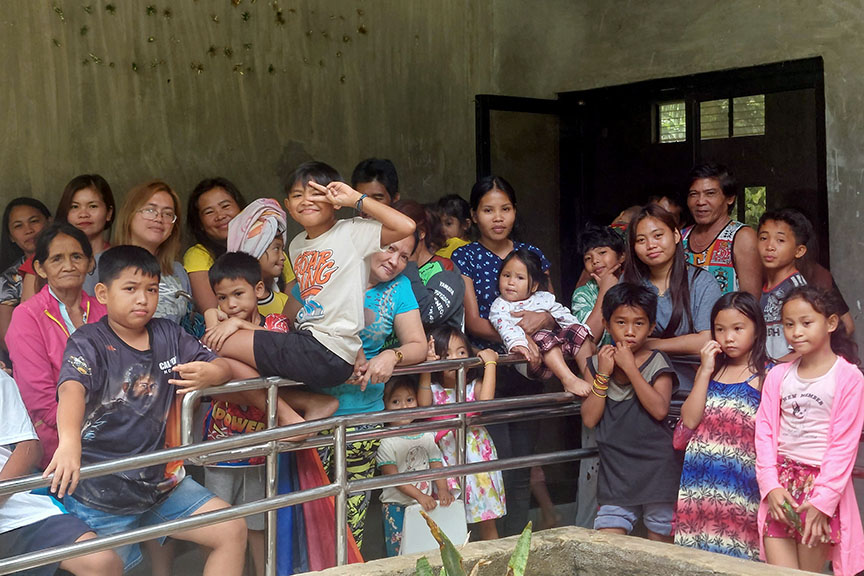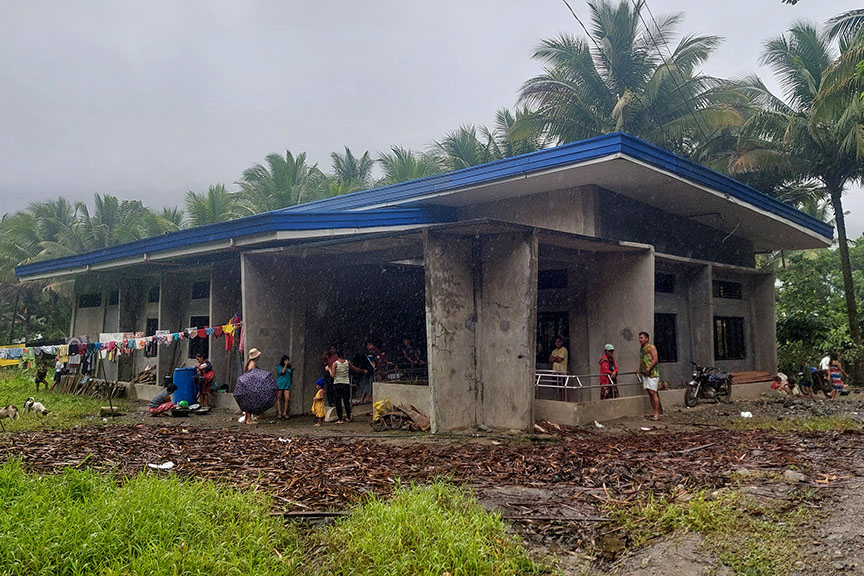MACO, Davao de Oro (MindaNews / 12 February)—At least 35 families occupying a still unfinished evacuation center in Patagan, Barangay Elizalde are hoping relief agencies will come as their ration of half a kilo of rice each is fast running out.
 The evacuees of Patagan in Barangay Elizalde, Maco municipality who asked to be photographed on Sunday (11 February 2024). MindaNews photo by YAS D. OCAMPO
The evacuees of Patagan in Barangay Elizalde, Maco municipality who asked to be photographed on Sunday (11 February 2024). MindaNews photo by YAS D. OCAMPO
The Provincial Social Welfare and Development Office (PSWDO) listed 11 evacuation centers in Maco and neighboring Mawab town, where residents displaced due to continuous rains from the trough of a low pressure area and the aftermath of the February 6 landslide in Barangay Masara, sought refuge.
Eight of the 11 are government-managed evacuation centers. Other displaced residents sought refuge in three other areas classified on the list as “outside evacuation centers” such as the Immaculate Conception Quasi Parish of Elizalde, known here as Quasi.
Quasi is host to 263 families of 847 displaced residents, as of Sunday, said Fr. Lou Jay Colarines.
Ten minutes away from Quasi is Patagan, where at least 35 families (117 individuals) had sought refuge in a still unfinished evacuation center.
Located near a detachment of the 25th Infantry Battalion, the facility in Patagan according to the signage by the roadside, was constructed as a “municipal evacuation center” and funded by the Apex Mining Company, Incorporated’s Social Development of Management Program (SDMP) 2021 “in partnership with Municipality Local Government Unit of Maco,” but has not been turned over to the barangay.
It has four toilets and room that could accommodate 50 families.
“We wondered why we were not led here,” one of the mothers said, as everyone in the room huddled to volunteer their answers about their conditions there.
According to volunteers and residents in Quasi, the three other areas providing shelter to evacuees in Barangay Elizalde are the Elizalde Elementary School, Gedaro Residence where at least 20 families are housed, and at Bagsakan.
Some residents have been staying at the centers as early as February 4, or two days before the landslide in Barangay Masara, as they were forcefully evacuated due to the trough of low pressure area earlier in the week.
From the main road, the evacuation center in Patagan is accessible by foot or by motorcycle. It is a steep walk over rocky road, and when it rains, there’s mud. Four-wheeled vehicles might not make it across the flimsy 36-inch culvert that allows residents access to the area.
There are 35 families in this evacuation center. Outside, mothers take turns washing clothes with little or no soap. Most of the men are out, either tending to their homes along the Masara River or conducting business at the Incident Command Post, such as making sense of the missing and the dead.
There is running water, but the evacuees here say supply is intermittent. As for food, the supply is uncertain.
“Usahay mahatdan ug hinabang, usahay dili” (Sometimes help arrives, sometimes it doesn’t), said Mercy Aballe, who acts as the group’s leader.
 The still unfinished evacuation center in Patagan in Barangay Elizalde, Maco municipality photographed on Sunday (11 February 2024). MindaNews photo by YAS D. OCAMPO
The still unfinished evacuation center in Patagan in Barangay Elizalde, Maco municipality photographed on Sunday (11 February 2024). MindaNews photo by YAS D. OCAMPO
The families here have elected to ration what they have until someone else arrives to provide supplies. At nearby corners of tents they pitched indoors, the families keep within arm’s length small bags of rice, what’s left of a five-kilogram ayuda from Apex Mining and some hygiene supplies like toothbrushes and toothpaste. The evacuees are strict with drinking water, only using the one in the shared communal plastic water tank for more general purposes, like toilet use.
However, the four toilets in the facility are starting to show signs of clog, with continued use.
The evacuees aid they were visited by a barangay health worker once or twice this week. Some of the households pitch personal tents; in contrast to the more formal evacuation sites, these were camping tents, around six of them, pitched inside an evacuation center reminiscent of communal barangay halls.
The 35 families initiated the move to Patagan when they saw that the Quasi evacuation area was already crowded.
Jennifer Hernandez, 34, mother of five, said she was hoping for relief, such as blankets and other necessities. There is a roof over their heads, walls, electricity, some running water, and a few food supplies, but the floor tends to get cold during rainy nights.
The households make do by cleaning up and tidying the tiled floors once in a while, for that semblance of home.
“Luoy ang mga bata” (I pity the children), Hernandez said. Her eldest child is 18 while the youngest is a year old.
On February 4, a pregnant evacuee had to be evacuated to a family clinic in Nabunturan town so she could give birth there.
Rice, dried fish, underwear
While doing much better than Patagan, the Quasi evacuation center visit by MindaNews revealed what was supplied to the evacuees, and what was lacking.
“Rice,” one of the mothers said. “We need rice.”
As one of the places closest and most familiar to the provincial and municipal governments, Quasi had too much of one thing and too few of another.
“There’s a lot of noodles, and biscuits, and other food, too,” Annabelle Ocba, 54, told MindaNews.
But they said the rice supply here, too, is intermittent. “Bahala og pakapinan nila og marot nga bulad (We don’t care if they give us dried marot [a kind of local dried fish]),” another mother chimed in.
“You know what we need in Quasi right now? Panties and briefs,” another evacuee said. Everyone laughed.
Nature’s wrath
Kagawad Allan Dominguiano, 57, a resident of Purok 1 and a worker at Apex Mining, said the landslide was a learning experience for everyone in the community.
“There’s nothing we can do once nature hits back,” Dominguiano said. “The only thing we can do is to protect it.”
As if asking for proof they exist, the Patagan evacuees asked MindaNews: “Picturi mi, sir, palihog?” (Sir, please take our photos?) (Yas D. Ocampo / MindaNews)
